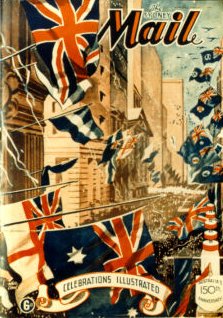| bc | Collecting
Magazines on the Collecting Books and Magazines website,
Blue Mountains, NSW, Australia.
Collecting magazines covers a wide field. I've listed below some of the genres and titles I have in my possession. If you're looking for a particular title or issue, send me the details and I'll list it on the CB&M 'wanted' page. Magazine content can be found on genre pages. For example, there is a recommended list of railway magazine articles on the 'Trains' page. And there's a 'Wide World' page. Note that our previous host, namely PENRITH LIBRARY, NSW, Australia, is attempting to complete its collection of the National Geographic Magazine. If you can help us with donations of required issues, please ask the library. If you have old magazines you'd liked identified, please note that magazines that have been damaged or defaced are usually worthless. Many I come across have had pages of advertising (usually soft drink or auto ads) removed. Movie magazines are usually judged by their covers. The most popular (in Australia) are those featuring Marilyn Monroe, Abbott and Costello, Elvis, The Beatles, James Dean, Judy Garland, Annette Funicello, Brigette Bardot and Audrey Hepburn. Any magazines featuring these stars are popular, no matter what the contents. Due to the weight of early magazines, .those prior to WW2, it's rarely worth the trouble of attempting to sell them outside of your home town or city, except for examples as mentioned above. The best place to sell is on eBay online auctions.
The
world's best motor mag?
Well-known authors' appearances in (mostly) long-forgotten magazines. The Australian
Journal: January 1, 1935. (Supplied by Greg Ray. water_gums@bigpond.com ) Page 100 - Editor's
column: "In Passing". Although this is Mr.
Upfield's first appearance in the Journal, he is of
course, one of the best-known authors in Australia, and
has half a dozen novels to his credit. Quite possibly you
have read "The Sands of Windee," "Gripped
by Drought," and "The Beach of Atonement,"
all of which had a very large sale throughout Australia.
Pictured on this page is the man who wrote them, and
here, in his own words, is an outline of his career: He Tells It
This Way "Well there was a job there for me all right, and the boss - a joker with a waxed moustache and the highest collar I ever saw; wonder it didn't choke him - told me to be there on Monday morning at nine sharp. But the more I thought of office work, the less I thought of it, if you understand what I mean. I went all cold on the notion of sitting at that desk from nine to five-thirty, with an hour off for lunch. So, without word to anyone, I went off into the bush, and left my boss-to lamenting. I'll bet he often wondered what the deuce happened to me. "You can believe me when I tell you that there were plenty of times during the next four years when I wished myself firmly seated on that office chair, with my pay envelope waiting for me every Friday. For there I was, carrying my swag, getting jobs on stations here and there whenever I wore out my boots and wanted a new pair. Yes, I humped bluey for four years. Solid years. The more I think of 'em the solider they seem! None of the people who saw me marching along the road in those days thought to themselves; 'That chap's going to be an author some day; I'll give him a lift.' Not they; all they said was: 'I don't like the look of that bloke with the six weeks growth of beard, he's up to no good.' After a while I got on in the world and bought a push-bike. The word 'push' is the right one; I pushed it from Port Augusta to Pine Creek, if you know how far that is. And then I pushed it back again. That's my record; I haven't broken it since, and I haven't any intention of trying. "I was on a pineapple plantation in Queensland when the Great War broke out, and I joined the A.I.F. in August, 1914, and put in the next four years keeping myself alive. I emerged at the other end of the war still whole, but without any medals. After the war I stayed in England awhile, working as private secretary to the head of a big ordnance plant, but I soon chucked it, and came back to Australia and the bush. That was in 1920. I began to think I'd wandered enough, and that it was time I put in a little work. I tried droving, rabbiting, kangaroo-hunting, prospecting, opal-gouging and anything else that was going. In 1927 I migrated to W.A., and worked for four years on the longest fence in the world, the Number One Rabbit Fence. By this time I'd acquired a wife, a son and a taste for scribbling. In 1925 started writing in my spare time, working in camel carts, station kitchens, in tents, on tucker-boxes under the mulgas - anywhere I could use pencil and paper. I wrote six novels under those conditions, and had them all published. In addition, I've contributed to 'The Daily Mail', 'The Wide World Magazine,' 'Review of Reviews' and other well-known periodicals. Now here I am in 'The Australian Journal.' Not a bad record for a swagman, eh?" # Back to Collecting Books & Magazines index page.
|
bc |





